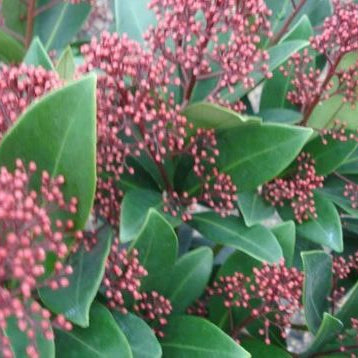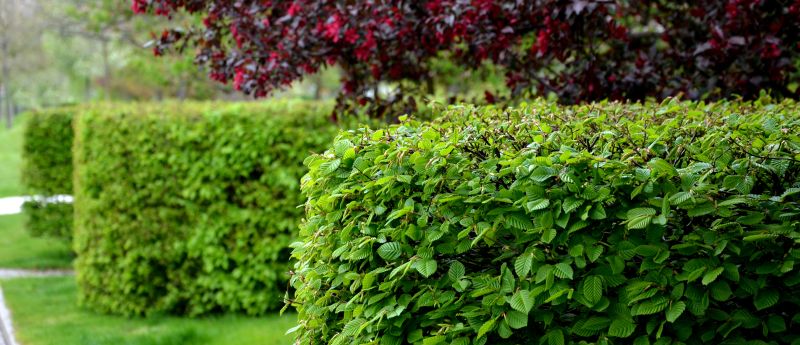
Free Delivery £400+*
Hedging, Tree, Shrubs & more
Free Delivery £400+*


Hornbeam is one of the UK’s most popular hedging choices. Hornbeam hedging makes the perfect formal hedge, due to its dense foliage and height. Thick greenery provides privacy in summer, before losing its leaves in the winter.
This guide provides all the information you need to keep your hornbeam hedge healthy and thriving. That includes advice on planting, watering, fertilising and pruning.
Hornbeam hedging is also known by its Latin name, Carpinus Betulus. It is a deciduous hedge, which means it loses its leaves every year. It regrows leaves every Spring, as well as catkins. These leaves are around 5-8 cm, providing dense foliage which is great for privacy. The leaves will turn yellow in Autumn, before dropping off in late Winter and starting the whole cycle again. It can reach up to 12 metres in height and grows at a rate of 20-40 cm a year.
At Grasslands we sell both potted and rootball Hornbeam hedging. Potted hedging comes in a container. Rootball hedging does not come in a container. Instead, it is dug up from its growing site with a ball of soil. The roots and soil are then wrapped up in a biodegradable sheet, which gives it some support as it grows.
Potted hedges have been grown in a container. That means they are often more developed and full than rootball hedges. It also means that the hedge tends to take better, as it hasn’t been dug up and disturbed. If you want to grow a hedge as quickly as possible, this is your best option. However, it is more expensive than rootball Hornbeam hedging.
Rootball hedges are dug up with a ball of soil before being wrapped in a sheet. This prevents damage to the roots and helps it take to its new site. The disturbance can mean they grow slower than potted options, or potentially fail altogether. In the long run they can grow larger because there is no container restricting their growth. Rootball hedges need planting as soon as possible to minimise disturbance. They are also considerably cheaper than potted options.
The best time for planting Hornbeam hedge is September to November. This gives the hedge chance to take root over Winter before the growing season starts. Choose a sunny or semi-shaded spot to plant your hedge. It’s quite an adaptable hedge so it can be planted in normal soil, damp (but not waterlogged) soil and even clay or sand soils.
When planting Hornbeam hedge, it’s important to make sure the ground isn’t frozen or waterlogged. This can kill the hedge before it has even has the chance to take root.
Follow these instructions when planting Hornbeam hedge:

Before planting your Hornbeam hedge, make sure the soil is well-prepared. Remove any weeds or grass from the planting area and loosen the soil to ensure good drainage.
 2. Dig a hole
2. Dig a holeIf you’re planting a potted Hornbeam hedge, dig the whole slightly bigger than the container. If you’re planting a Hornbeam rootball, you should dig a hole 20 cm deep for small plants (60-80cm) and 30cm for any bigger than that.
 3. Position the hedging
3. Position the hedgingWhen planting a Hornbeam hedge, you need to make sure the spacing is right to create a screen. Plants under 125 cm can be planted 30-50 cm apart. Plants that are larger than that should be planted around 60 cm apart.
 4. Fill with soil
4. Fill with soilMake sure the top of the rootball is level with the soil surface. Then, backfill the hole with soil, ensuring that the hedge is firmly held in place. Don’t make it too compact or the roots won’t have room to grow.
 5. Water and add fertiliser
5. Water and add fertiliserWater the newly planted hedge to settle the soil. You can also add Vitax fertiliser to help promote growth.
Watering and irrigation are an important part of maintaining any plant. You should water your Hornbeam hedge vigorously straight after planting. After that, you should only water on dry winter days. Whilst Hornbeam hedging does grow in damp soil, it doesn’t like waterlogged soil. Be careful not to overwater it to avoid creating waterlogged soil.

Like most plants, Hornbeam hedging can benefit from use of fertiliser. This isn’t necessary in already nutrient rich soil, but can help the hedge grow in poor soil. We recommend a compost mix or a
Hornbeam hedges only need fertilising immediately after planting, or when they are showing signs of poor growth. Fertilisation should take place in the Spring. Don’t fertilise in the Winter or this can lead to frost damage.
Hornbeam hedges need pruning once or twice a year to keep their shape, once they’ve hit maturity. Pruning is best done by hand with shears, instead of a hedge trimmer. Make sure you cut from the stem to avoid killing leaves. If you slice a leaf it will die and turn brown, discolouring the hedge.
You should not prune a Hornbeam hedge in winter. This is when it is most vulnerable and you could cause leaves to die. It will drop its leaves naturally when it’s time for new leaves to grow.

Hornbeam hedging can attract caterpillars and aphids. We would generally leave these, as they form part of a healthy ecosystem and are normally picked off by other animals anyway.
Hornbeam hedging is also prone to powdery mildew, which can leave a white dusty coating on leaves. Prevent this by planting in full sun and avoid planting too close together, to allow air to circulate. If your hedge is infected, rake up diseased leaves to stop reinfection next year.
Hornbeam hedge can also be vulnerable to coral spot. This is a fungal infection which leaves small coral-pink raised bumps on the stems. Cut affected branches to avoid this spreading to the rest of the hedge.
Care for your Hornbeam hedge in the winter by following our advice. During Winter, most Hornbeams will hold onto their golden-brown leaves before dropping them ready for Spring regrowth. That means you will have a bit of raking up to do.
We hope this has given you some ideas about how to plant and care for your Hornbeam hedge. The Hornbeam is a great choice of garden hedge, it’s hardy and provides plenty of privacy for your garden. It can be planted in almost any type of soil, apart from waterlogged soil.
Once planted, it will need pruning once or twice a year. It will also need leaves to be raked up in the winter. Other than that, it’s a very self-sufficient plant and should flourish in your garden!
At Grasslands, we sell both potted and rootball Hornbeam hedging. You can order online via click and collect or get it delivered to your home. You can also call in to the Nursery to buy in person. We’re open everyday including Bank Holidays!
Cherry laurels are a very popular hedge as they are evergreen and can grow upto the 3 feet a year. Laurels have large, glossy green leaves, very sm...
View full detailsPrunus Lusitanica - Portuguese Laurel are fantastic laurels that are a great alternative to the classic cherry Laurel. They are more formal in app...
View full detailsBrenelia is a very hardy form of portuguese laurel that also grows a little faster, in a very tidy manner with much redder stems. More graceful in...
View full detailsClassic laurel hedging. It's the country's favourite hedging shrub. Lovely luxurious evergreen dark green leaves. Grows easily in all soils except ...
View full detailsThe posh form of laurel hedging. They cost a little more than common laurel but they are more graceful in appearance with purple shoots and finer l...
View full detailsPrunus lusitanica Angustifolia - Portuguese Laurel are fantastic laurels that are a great alternative to the classic cherry Laurel. They are more f...
View full detailsClassic laurel hedging. It's the country's favourite hedging shrub. Lovely luxurious evergreen bright green leaves. Grows easily in all soils excep...
View full detailsPrunus lusitanica Angustifolia - Portuguese Laurel are fantastic laurels that are a great alternative to the classic cherry Laurel. They are more f...
View full detailsPrunus lusitanica Angustifolia - Portuguese Laurel are fantastic laurels that are a great alternative to the classic cherry Laurel. They are more f...
View full details